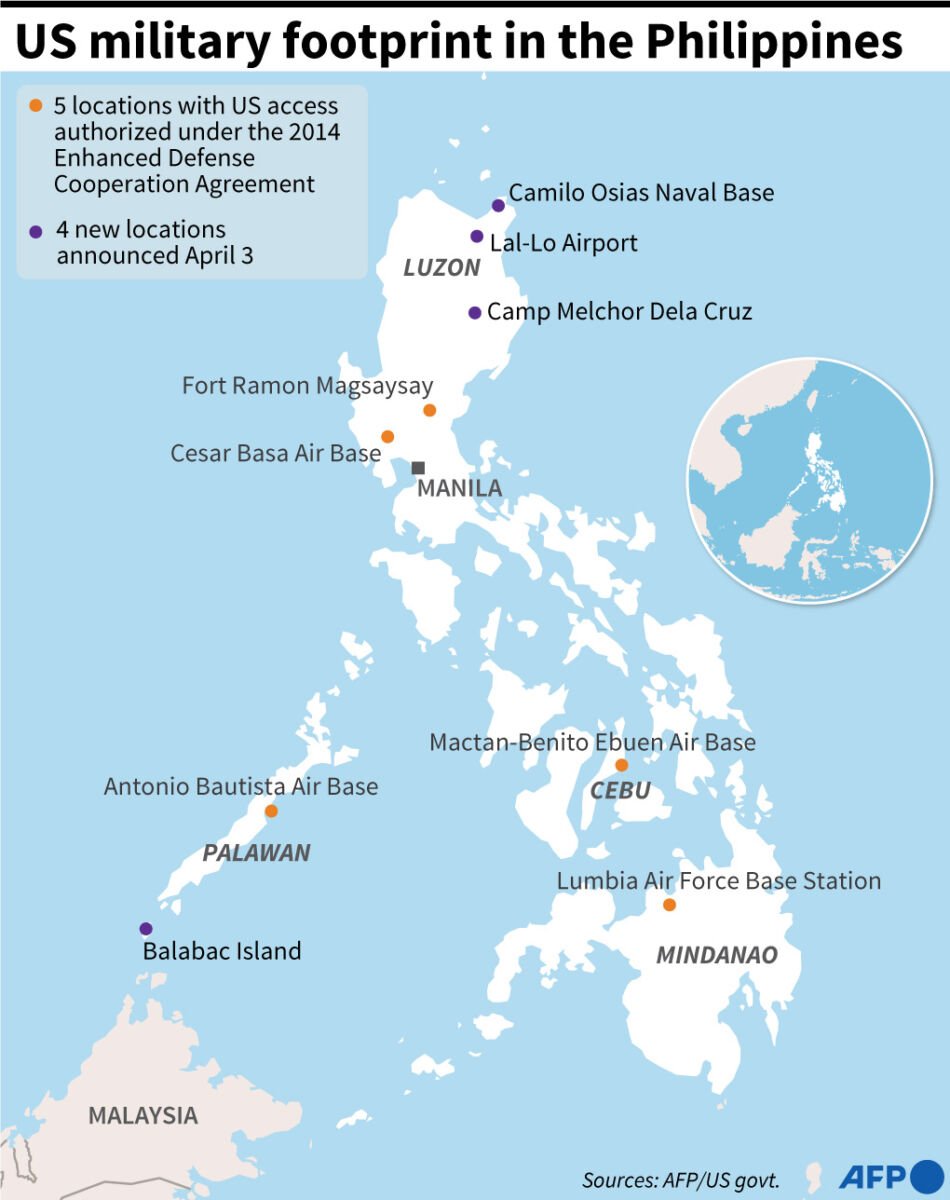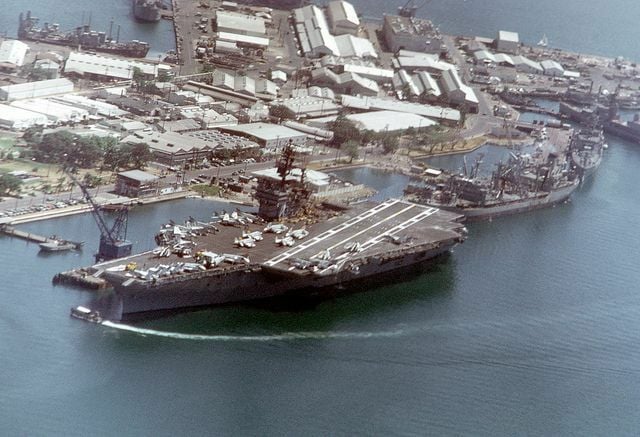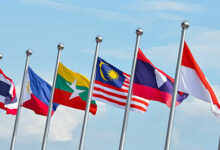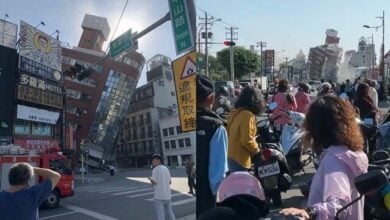US granted permission to expand military presence in the Philippines: What does it mean?

News the United States has been permitted by the Philippines to open four new military bases on the Southeastern Asian archipelago may have slipped under the radar of most mainstream media outlets but not this one. But what does it mean?
Philippines President Ferdinand Marcos immediately went on the defensive insisting that Manila will not allow “any offensive actions” from the bases it has opened to US troops, which usually translates that it will, in politician speak.
The locations of the four military bases, on top of the five agreed on under the 2014 Enhanced Defense Cooperation Agreement (EDCA), include Naval Base Camilo Osias in Santa Ana, Cagayan, Camp Melchor Dela Cruz in Gamu, Isabela, Balabac Island in Palawan, and Lal-lo Airport in Cagayan.
The alleged deal allows US troops to rotate through and store defence equipment and supplies.
Three of the new military bases are situated near Taiwan while the other faces the South China Sea.
China, understandably, accused the US of fanning the flames of war.
Marcos said China’s reaction over the expanded military deal was “not surprising,” but assured Beijing that the Philippines is only shoring up its territorial defence. Marcos said…
“We will not allow our bases to be used for any offensive actions. This is only aimed at helping the Philippines whenever we need help. If no one is attacking us, they need not worry because we will not fight them.”
Warmongering US
Marcos appears to be suggesting the Philippines will come under attack from China, a bizarre suggestion given the mainland has never invaded another country in modern history. Yes, it has had border skirmishes with India, and Vietnam and assisted Communist countries in the Vietnam War and Korean War since the end of World War II but this pales into insignificance in comparison to the warmongering US.
A China Society for Human Rights Studies report reveals that from the end of World War II to 2001, the US has “initiated 81% of armed conflicts in the world.”
From the end of WWII in 1945 to 2001, said the report, “Among the 248-armed conflicts that occurred in 153 regions of the world, 201 were initiated by the US, accounting for 81% of the total number.” That does not include the social, political and economic carnage caused by US interference in Libya, Iraq, Syria, and Afghanistan.
The US cannot keep its nose out of other nations’ foreign affairs, and those self-anointed guardians of the galaxy trying to “Make America Great Again” have been beating the drums of war against their next target, China for decades, according to award-winning journalist John Pilger.
Their warmongering has been ramped up to hysterical levels over the past few years using Taiwan as a flimsy excuse, ignoring the One-China policy the US acknowledged in 1972.
Of course, the new military bases in the Philippines will allow the US military to attack China quicker on the premise that they looked at them funny.

Civil and social unrest
China is not the only nation unhappy the US will once again have a large military presence in the Philippines, after they were told to leave in 1992 following decades of civil and social unrest.
Co-President of the intelligence preparation of the battlefield (IPB) Corazon Valdez Fabros has been organizing against US military presence in the Philippines since the 1970s. She said…
“Imagine you have a visitor who comes into your house. You welcome this visitor. But this is a visitor who has all the guns, all the materials, that basically you cannot object to because they are fully loaded. And you cannot even tell this visitor to get out of your house when you want them to get out.
“That is the US.”
US military presence in the Philippines has caused deep concern among social movement leaders who oppose it. These leaders note that US lawmakers seldom address how such military expansion in the Indo-Pacific region affects countries like the Philippines, where the US military has already caused significant harm, including sexual assault to child abandonment.
This expansion in the Philippines is just one part of a larger effort by the US to build up its military presence in an arc surrounding China. According to the Pentagon and the Overseas Base Realignment and Closure Coalition, there are at least 313 US military installations in East Asia and roughly 750 military bases across the globe.
According to David Vine, a professor of anthropology at American University who has written extensively on US military bases, China currently has one military base in Djibouti and several others in the South China Sea, bringing its total number of foreign military bases to around eight.
China asserts that its sovereignty extends to the areas where these South China Sea bases are located, but The Hague’s Permanent Court of Arbitration has disputed this claim. As a result, this issue has caused tension between China and nearby countries like the Philippines.
China-US tensions
Valdez Fabros, who serves as co-president of the anti-war IPB network, is worried that any increase in the US military presence could heighten the risk of war between the US and China. She said…
“This may not be something that for sure is going to happen. But the mere fact that the US is here makes it more likely something can happen. Maybe there’s a miscalculation. These things happen.
“Why can’t they do this training in their own country? That makes more sense. Of course, they’re doing it here to be aggressive. Were a hot conflict to erupt the US military presence guarantees the Philippines would be dragged into it.
Roland Simbulan, a professor of developmental studies and public management at the University of the Philippines and author of The Bases of Our Insecurity, a study of US military bases in the Philippines, shares this fear. He said…
“The biggest danger is the fact that the US presence in the Philippines will put us in danger of possible attacks on our territory and people in case there is a war between China and US forces. We are the first line of defence in the US strategy.”
For Renato Reyes Jr., secretary-general of Bayan, the US presence itself inflicts harm, regardless of whether it leads to war. He said…
“It violates our sovereignty. It’s a clear sign that we are not really free.”
US military problems in the Philippines
The Philippines was under US colonial rule from 1898 to 1946, during which time the US military enforced its control and brutally repressed anti-colonial rebellions. The US waged a violent campaign against the independence movement from 1899 to 1902, burning down entire villages and causing the deaths of up to 20,000 Filipinos in combat, as well as many as 200,000 civilians from starvation, disease, and war-related violence. Despite the Philippines winning independence, the US maintained two large bases in the country, which it used as a launching pad for military interventions in the region, such as the suppression of the Boxer Rebellion, the Korean War, and the Vietnam War.
The Philippines finally ousted the US military in 1992 after a strong anti-bases’ movement.

In an April 3 statement, the Department of Defense tried to put a positive spin on the local impacts of the increasing US presence, claiming that infrastructure investments would boost economic growth and job opportunities. However, activists are concerned that when the US previously employed tens of thousands of Filipinos at Clark and Subic Bay bases, those workers faced exploitation and wage discrimination, as the US claimed it could override Philippine labour law. The inequality between Filipino and US civilian workers on bases led to labour organizing and major strikes.
Valdez Fabros, co-president of the anti-war IPB network, is troubled that the US is expanding its military presence in the Philippines without addressing its past environmental harms. In a 1992 report to Senate leadership, the US General Accounting Office acknowledged its environmental destruction in the Philippines.
Both Clark Air Base and Subic Bay Naval Facility in the Philippines have contaminated sites and facilities that do not meet US environmental standards. For example, heavy metals from the ship repair facility at Subic Bay drain directly into the bay or are buried in the landfill, and the power plant at the same location has unknown amounts of polychlorinated biphenyls (PCBs), which are probable human carcinogens.
Living near US military base locations in the Philippines has been associated with a higher incidence of health problems like cancer, leukaemia, heart conditions, and miscarriages.
Given this, Valdez Fabros is not only concerned about the environmental impact of the new US military locations she said, “The US visitor brings danger. We don’t want any part in a war.”
A war-thirsty US has no concerns about what other people want, if they want blood, they will take it. History has taught us that much since 1945.
Join the conversation and have your say on Thailand news published on The Thaiger.
Thaiger Talk is our new Thaiger Community where you can join the discussion on everything happening in Thailand right now.
Please note that articles are not posted to the forum instantly and can take up to 20 min before being visible. Click for more information and the Thaiger Talk Guidelines.










Recent comments: